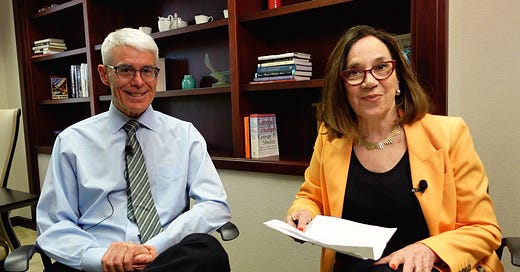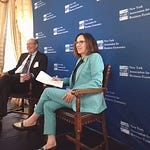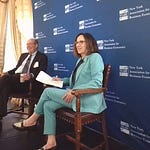Darrell Duffie does what so many find hard to do, that is so useful to people like me, who find the world of financeand bank regulation a much more difficult one to understand than the macroeconomic issues that often dominate central banks’ policy decisions. He takes the the technical, opaque, issues on the mechanics of financial systems and makes them clear, and easy to understand.
The Federal Reserve Bank of Minnapolis put it perfectly in an article written in 2012, reflecting the mark Darrell had already made on his profession, on his lifelong passion.
“In this increasingly vital yet bewildering world of financial economics, Darrell Duffie is both a deep-level theorist and a hands-on plumber. He marries abstruse theory with solid reality and, unlike most economists, can then lucidly explain this often awkward union to those without his intuitive grasp. Few are better suited, then, to evaluate and clarify key challenges in the aftermath of the recent financial crisis. Duffie can’t eliminate the fog, of course, but his insights are among the sharpest.”
Darrell joined me at here at Stanford University, where he has been a professor of finance at the Graduate School of Business since 1984, as the Hoover Institution held a special annual monetary policy conference over two days instead of one. First, A Celebration in Honor of John Taylor, followed by a look at the path of current Federal Reserve and global central bank policy, with the impact of the Taylor Rule threaded through it.
Enter Professor Duffie. As much, and sometimes more, than maintaing price stability it is the Fed’s failure to maintain financial stability where it has failed. Dive in and hear what he has to about Fed’s balance sheet, and his views and recommendations about other pressing financial system challenges.
Please note: If you want to see Darrell’s panel — and others at Hoover’s celebration of John Taylor and much more - here’s the link: https://www.hoover.org/events/celebration-honor-john-taylor
How large should the Fed Balance sheet be? 00:01:52:03
A great question, Kathleen, and it's foremost on the mind of the Federal Open Market Committee, as you noted. And when most people think about that question, they're thinking about how much in assets does the Fed need to own and what kinds of assets. And the Fed's come under some criticism for quantitative easing programs and purchasing assets other than Treasury securities. Kevin Warsh, who's widely suggested to be a potential future chair of the Fed, recently gave a speech at the IMF criticizing the Fed's balance sheet policy. In my research, though, I've been focusing not on the assets that the Fed has, but on the liabilities that it has. That is, the deposits that banks keep at the Fed.
The Government 00:03:11:21
They need a lot of reserves. There are the deposits of commercial banks at the Fed uses to do their job. What is it in danger of getting out of balance? So from the viewpoint of the government, it has an account called the Treasury General Account or TGA, and that's its cash management account. That's how it processes payments into the economy. At first it's issuing Treasury securities into the market and it takes the cash that it gets and deposits it at the Fed and the TGA account and the Treasury Department is found over the last two years that it needs quite a hefty sized account at the at the Fed, particularly because of the debt cap discussions.
Commercial banks: reserves -00:04:01:20
In my research, I've been focusing on the even bigger amount of deposits at the Fed that are held by commercial banks. Those are called reserves. Okay. And those banks need those reserves to pay each other and everyone else in the economy within every day. And they make trillions of dollars of payment every day. And if they don't have enough reserves at the Fed, they can't process those payments. There are also demands on those banks to lend those reserves, especially in the repurchase agreement, market or repo market. And if they don't have enough balances, that market can blow up like it did in September 12, 19. So in summary, the liabilities of the Fed, not its assets, really are the main determinant of the size of the Fed's balance sheet.
Size of the US treasury market is crucial 00:05:11:00
And they need a lot of those deposits to meet the needs of depositors like us, but also financial market participants. What makes that ebb and flow? Because if we're thinking about crises or crunches or what how financial regulators have to look at what's in existence now and changes that may be need to be made over the years, particularly when you have a big budget deficit, eventually, when the Treasury has a lot of obligations that raise yields that go up and down lately. So what determines that? Well, the size of the Treasury market itself is a huge determinant of how much reserves those banks need because investors all over across the world are financing those reserves, financing their treasuries by borrowing reserves. And so the banks need enough reserves to process those repos. That's a lot. And that's a $11 trillion a day market.
Daily settlement 00:06:02:13
But as I mentioned, there are trillions of dollars of just ordinary payments that have to be made every day. And if you don't start the day with enough reserves, you're not going to pay other banks with reserves until you get some from the other banks. And that can set up a gridlock in which your if there's not enough reserves in the system, you're waiting for reserves to come in so that you have enough to send reserves out every day. Is it whether or not there's enough reserves in the system? Is it also how much I'm kind of leveraging or kind of playing with the reserves or what my obligations are to current repo markets? There can be crunch times when, you know, recently there's been a lot of volatility in the Treasury repo market and there are crunch times at which there's not enough reserves to meet those demands. So last big one was in September 2019, and the Fed doesn't want to have that happen to share. So the Fed, as you mentioned, has been reducing the size of its balance sheet more and more slowly. This is the second time that it's slowed down the pace of quantitative tightening to make sure that there's enough reserves in the system to meet all the needs that the banks have.
Balance sheet fluctuations and signaling- 00:07:24:05
The Fed's going to shrink the balance sheet or increase the balance sheet. It isn't necessarily about the economy. This is much more about how the financial system is working and what the stresses and strains are there. So the question What's the optimal size of the balance sheet? Can you know, how do you know with any level of confidence what that is? Okay. So right now the Fed has a larger balance sheet than it needs, and that's why it's reducing. And now the $64 trillion question is how much is just enough? And the Fed calls that just enough regime, an ample reserves regime. And it's really difficult to know exactly how much is enough. In fact, when I was on that sabbatical at the New York Fed, I worked with Adam Copeland, an economist there and a former Ph.D. student, Elaine Yang, on how do you know when you're getting towards too little? And we found that rather than trying to look at the quantity of reserves, were the interest rates at which those reserves are being lent in the market, it's much more effective to look at the intraday payments that banks are making because when they're running short, they tend not to pay each other early in the day. They're holding back in case they run short. And so they're paying each other later and later in the day. And once you see that delay in payments from one bank to another, especially to the largest banks, you know that you're getting to the end of the runway and you need to stop.
Shrink, but shrink slowly 00:09:16:08
Federal Reserve Bank of Dallas President Lorie Logan < and Governor Chris Waller> was also an early speaker of the Fed, suggesting that they should go slowly. And she made the point that if you go slower, you might actually get to an even lower potential balance sheet because there's more time for the system to adjust. And I thought that was a very perceptive remark. And the Governor Waller supported that view. And so I strongly support going slow because you definitely don't want to blow up the financial system by not having enough reserves. And it also it's not a good look for the Fed when markets get disrupted like they did in September of 2019.
Avoiding a ‘collision’ 00:10:49:02
I don't see a collision course. In the last round of quantitative tightening in 2018 and ‘19. The Fed was moving it was doing its quantitative tightening at a pretty rapid pace. And it went smack on to the, you know, onto the tarmac pretty heavily this time. The Fed, as I mentioned, is being very careful in its monitoring It has a whole dashboard of data that it's looking at to make sure that it won't push the banks so hard that there's a liquidity crunch like there was in September of 2019. And of course, as you touched on the balance sheet, liquidity, etc.. But okay, so where exactly are we then, with the balance sheet? How much more can it shrink? And everybody still seems to think it needs to shrink, Right? But where is that shifting to in terms of what people are looking at? Perceptions have been changing. I mentioned Kevin Warsh's speech at the IMF last week. I thought it was a terrific speech. And he was quite critical of the Fed's balance sheet problem of balance sheet size and said that $7 trillion, which is roughly where it is now, is excessive.
Potential political elements- 00:12:34:09
Americans are wondering whether the Fed is doing more than it needs to do by having such a large balance sheet. Mm hmm. And so there's a footprint sometimes called a footprint issue. Okay. Which is, is the Fed too big for its job? I mean, you can shrink. So that's a politically, in my view, it's mainly a political issue, because if the Fed focuses on reducing its balance sheet to the natural size, it'll still have a pretty big footprint, but it'll be doing its job effectively. The second sort of political or optical issue is that the more reserves that the banks have, the more interest the Fed has to pay to them on those reserves. And that's a lot of money. And the Fed has been generating not income, but expenses for the government in the last few years because it has to pay so much interest on those reserves to the banks. And that, you know, that's something the Fed doesn't really want to do. Other central banks are addressing that problem as well. The European Central Bank, for example, is trying to educate or encourage banks to let their reserves go down. But to come to the ECB. Exactly when they need more reserves. They call that liquidity on demand. And so they're trying to train their banking system in Europe to go leaner on reserves in normal times, but then go to the ECB when they suddenly need more.
The issue of stigma- 00:14:11:09
The Fed has had a difficult time with that because of what's called stigma. Oh, yes, Banks don't want to appear to need more reserves. And in fact, liquidity regulations on the banks since the financial crisis have suggested the banks are not supposed to need more reserves from the Fed. They're supposed to manage their liquidity on their own. So you know, in terms of ways to address this, I think one of the things the Fed should think about is modifying its liquidity regulations so that banks feel free to dip into their liquidity buffers when they need to use them and feel free to go to the discount window and borrow more reserves when they feel they need them.
The discount window 00:15:36:17
There was some discussion of making sure that the discount window was open, accessible, efficient and had been tested by banks to make sure they could access it. And there were issues there. And then the other issue is more of a perception issue. Even if the discount window were working perfectly with banks, feel free to go there and demonstrate, in effect, that they ran out of reserves. And the answer so far has been no. Okay, so the Fed needs to address that perception issue among the banks. Okay, two more real quick. You can make a more like lightning round question. Lightning round. Lightning round for MarketWatch Wash watchers. Are there any published data that we could be tracking? I mean, we don't bankers, we're not. Darrell Duffie But just people are interested and want to know that will let people know if the reserve markets become illiquid.
What data can markets track? 00:16:26:20
Yeah, well in terms of what data are available publicly, I would be looking at what's called the secured overnight financing rate, which is the rate on multiple trillions of dollars of overnight financing in the Treasury market. And that's the average rate at which investors and treasuries are financing their treasuries in in what's called the repurchase agreement market. That number is put out by the New York Fed. And when that number gets high relative to the federal funds rate, or probably a better benchmark would be the interest that the Fed pays to banks on their reserves that spread between Sofr and interest on reserves is a gauge of how scarce reserves are in the system. And so that's a that's one that the public can watch. Now, unfortunately, that one can spike unexpectedly. That's what happened September 2019. So you can be watching it and it can be moving up very gradually and then suddenly it can pop. Hmm. But there are other numbers that the Fed can see that are not available publicly. Like when do banks pay each other during the day, Right. That the Fed can watch.
What you would change… 00:17:53:06
Just. Well, I would want to change the liquidity coverage ratio, but most importantly, the, uh, the intra day liquidity stress tests that banks have to meet and how those tests are performed. I would also, uh, make some adjustments in what's called the standing repo facility, which is a way that the Fed can inject reserves whenever secure securities dealers like big banks like JP Morgan Securities need to borrow money. Those are also stigmatized. Those standard repo facility financings are stigmatized. And so the Fed could do more to make those facilities more broadly available and less stigmatized. So some adjustments there would be helpful. And the Fed is already looking at that. They've encouraged banks to come to that facility. It wasn't really heavily used when it could have been used last September 30th.
Stanford conferences and John Taylor 00:18:55:18
Finally, you're excited about tomorrow. It's the second day or the second event here at Hoover. You people can watch streaming live. It'll be online. What what would you urging them to listen What would you give them? What are they going to learn from you? Darryl Duffey When you're on, I think at 9:45 Pacific time, well, even much more important than tomorrow is the fact that day today we're honoring. That's right. Oh, please say that John Taylor has been my colleague at Stanford for decades, a man that I respect as a scholar and as a friend. Beyond words and the opportunity to honor him today is just it's just a wonderful, wonderful occasion of academic celebration and discussion of policy policies that he's been involved in throughout his career.
Darrell Duffie is The Adams Distinguished Professor of Management and Professor of Finance at Stanford University’s Graduate School of Business. He is a Research Fellow of the National Bureau of Economic Research and a Fellow of the American Academy of Arts and Sciences. Duffie is a past president of the American Finance Association and chaired the Financial Stability Board’s Market Participants Group on Reference Rate Reform. He is an independent director of the Dimensional Funds and a member of the leadership teams of the G30 Working Groups chaired by Tim Geithner on Treasury Market Liquidity and chaired by Bill Dudley on Bank Failures and Contagion: Lender of Last Resort, Liquidity, and Risk Management. Duffie’s most recent book is Fragmenting Markets: Post-Crisis Bank Regulations and Financial Market Liquidity, DeGruyter, 2022. In 2024, Duffie is teaching a new course at Stanford, “The Future of Money and Payments.”














Share this post